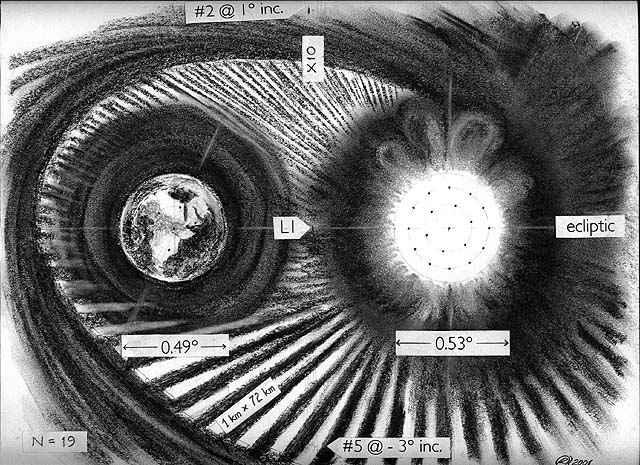

On the left is Earth as seen from the center of the 19-element array of sunshades, 10,000 km diameter, orbiting the Sun-Earth L1 point, 1.5 million km towards the Sun. The shadow spots on Earth, indicated by blue dots, are shown in correct scale for 0.25% occlusion. Earth subtends 0.49 degrees of arc from L1. The view is centered on the Great Rift Valley where humans probably first evolved; this picture was suggested by the famous snapshot taken by the Galileo probe on its last slingshot maneuver by Earth.
On the right is the Sun as seen from the Earth, subtending 0.53 degrees of arc. The sunshade array is superimposed on the solar disk as it would appear from the surface of the Earth, ignoring glare.
In the middle of the image, is an edge-on view of the central unit and inner ring of sunshades, at 10X the scale of the right, or approx 5000 km from top to bottom. The tiny red dashes are the sunshades. The outer ring cannot be seen at this scale. The central element is parked at L1; all the others orbit (slowly) the L1 point.
One sunshade concept, a "daisy", illustrated in the background, has "petals" that can be rolled in or out in order to modulate the insolation on the planet below. Each petal is 1 km wide by 72 km long and is made primarily of lunar aluminum. The petals may be linked at their tips by a circumferential cable of unusually strong material. The rollers can twist on their long axis to spin up/despin the daisy with light pressure. Each roller could also be equipped with electric jets for gross motion during assembly. The solar power transmitter and robotic controls could be located at the hub of the daisy. A complete sail could mass many megatonnes.
Components could be manufactured from lunar minerals, and launched via solar powered maglev into an assembly yard at the stable Luna-Earth L4 point. Once assembly is complete, the petals would partly unfurl, the daisy would spin itself up, and a solar powered launch laser could push the daisy to the final station at the Sun-Earth L1 point (or anywhere else in the solar system for that matter).
Each element of the array occupies its own orbit about the L1 point; spinning on its own axis at no more than ~ 0.1 rpm. The spin provides structural rigidity via tensioning, but the rate in this concept limited by aluminum's 350 MPa tensile strength. Because no two orbits are coplanar, i.e., each orbit is inclined from its neighbors by several degrees, tangentially expanding debris from one structural failure will be unlikely to cause a cascading failure by hitting the other sunshades. Image © 2001 by Robert Kennedy, PE.